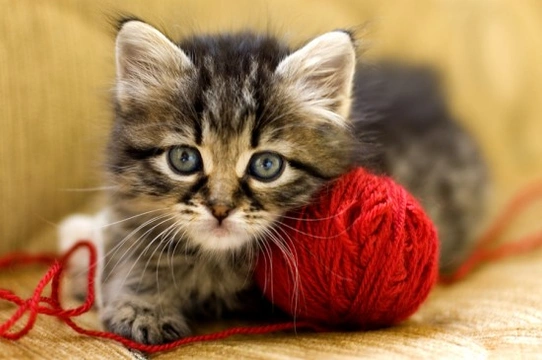
Wool-eating in Cats
Some cats display a tendency to suck, or even eat, woollen articles, which ultimately can have a detrimental effect on their intestinal systems. Research shows that the breeds most pre-disposed to this habit are Siamese, Balinese, Oriental, Burmese and crossbreeds deriving from them, but nobody knows for certain what causes this behaviour, and it is fortunately only a relatively small minority of cats that acquire this habit.People often assume that wool-eating cats must have been taken away from their mothers at too early an age, and that the wool is just a mother substitute, but this is not the case as it can just as easily occur with cats that have remained with their mothers up until they were at least 13 weeks of age. It often doesn't develop until a cat is several months old, and can sometimes be outgrown by the time they are two years old, but if you have a wool-eater, it does need to be very carefully managed. One way of combating the problem could be to try your cat on a high fibre dry food, as chewing wool may mean that your cat is lacking adequate fibre or certain nutrients in its diet, and this may help to eradicate the problem. It will also have the added advantage of helping your cat to feel full, so that he will not want to start chewing other items. Another solution could be to ensure that your cat has plenty of toys to play with or other means of stimulation, in case boredom is the cause of the problem. Some owners have found that a chew intended for a dog will often help to resolve the situation. Maybe even another feline companion would help if you only have one cat and you are out a lot, as they may need the contact and interaction of another cat. In the most determined wool-eater, they will sometimes even try to suck on a woolly garment whilst you are still wearing it, to the extent that they will actually chew a hole in it. Once you are aware of the situation you will need to try and avoid buying any fabric containing wool, or if you have such items, be sure to keep them out of the way of your cat, as a determined wool-eater will keenly seek them out. You will need to make sure that your cat cannot gain access to your bedroom or other rooms with woollen items, as doors and cupboards with closed doors are often more accessible to a determined cat than you would imagine! Avoid woollen toys and bedding for your cat, and if you enjoy crafts using wool (such as knitting or tapestry) be sure to keep your cat well away from temptation. If you catch your cat starting to suck a woollen item, shout at them and discourage them away from this habit, as it could have extremely serious repercussions for them - and never let them think that you find this behaviour amusing. Do not give them even one woollen toy so that they can indulge their habit on something that is theirs, as it could lead to disaster. It appears that wool eating is often a hereditary problem, and so if you have a cat with a serious problem, you should consider not breeding with them in case the habit is passed on. Often if cats eat something they shouldn't, it will pass through their digestive system and be expelled naturally. Wool comprises many tiny fibres which could well turn into huge balls that become an obstruction and will be impossible to pass, or the fibres can become attached to the intestine and effectively block it by restricting the passageways. If you suspect that your cat has swallowed significant amounts of wool, or, worse still, if you spot a piece of wool hanging from your cat's mouth or rectal area, seek veterinary help immediately as irreversible damage could be done very quickly. Do not attempt to pull the wool from either end as you will probably cause further damage, and there is always the possibility that your cat may also have swallowed a needle if you have a sewing box. If your cat is retching without being sick, or even if they are vomiting up frothy bile, this too could be an indication that your cat has swallowed some wool it cannot pass - or they may paw frantically at their mouths because something has got stuck and they feel that they are choking. Other symptoms can include diarrhoea, lethargy and unwillingness to eat, all of which can come on suddenly in an otherwise healthy cat, and require immediate medical help. With some cats, this behaviour appears to be a compulsion, and if you are at all concerned about being able to manage it, you should seek help from your Vet who may be able to prescribe something to help. However, although this will help in some cases, it can take months for the medication to take effect, as the exact dosage has to be calculated, and there may be some undesirable side effects. In the most extreme of cases, your Vet may suggest a visit to an animal behaviourist to try and overcome the problem. However, in most cases of wool-eating cats, the situation is manageable by means of a responsible pet owner monitoring the availability of woollen items, and the solution in all but the most extreme instances is to ensure that temptation is kept out of the cat's way.



